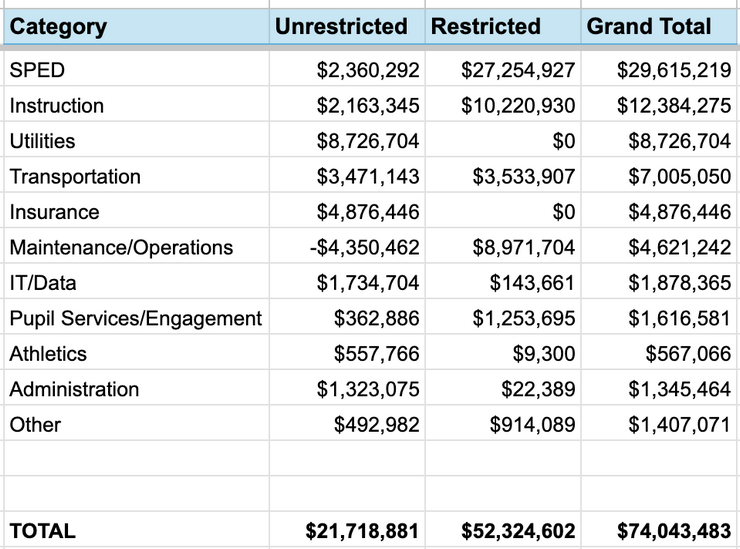
Dr. Blanco described the financial challenges confronting the District as severe but manageable through strategic, phased cuts and community involvement.
The District, still reeling from the devastating Eaton Fire, faces a $37 million three-year deficit — reduced from an original $47 million deficit after voters approved Measure EE in November. This financial challenge is driven by declining enrollment, rising costs and insufficient state funding. PUSD is not alone in its troubles, with “the overwhelming majority of California school Districts” experiencing similar challenges, according to Dr. Blanco.
While the advancement of insurance funds has helped the District maintain a “positive certification” in its Second Interim Financial Report, these monies are in fact already designated for school restoration and cleaning.
Dr. Blanco explained that public school funding in California is based upon a system of average daily attendance (ADA), which means that funding is lost for every single day a student is not in school. But importantly, PUSD will be “held harmless” for enrollment losses due to the Eaton Fire for this year and the 2025-26 school year. California will maintain PUSD’s funding as if student enrollment and attendance had remained at pre-fire levels, Dr. Blanco reported.
The District’s difficult budgeting decisions are being guided by recommendations from both a Superintendent’s Budget Advisory Committee and a comprehensive planning process, according to the email.
Despite cuts, Dr. Blanco emphasized the District’s commitment to preserving educational programs including dual immersion, college and career academies, arts education, International Baccalaureate, Advanced Placement, athletics, and services for students with specialized needs.
Dr. Blanco acknowledged the emotional toll of the reductions but maintained they were necessary to prevent even deeper cuts next year.
As PUSD navigates uncertain financial waters, including potential compensation changes and federal funding cuts, Dr. Blanco called for continued advocacy for additional government support while expressing gratitude to the communities of Pasadena, Altadena, and Sierra Madre for their ongoing support during these challenging times.
Below is the entire open letter as issued:
March 12, 2025
Dear Pasadena Unified School District Community,
I want to address our current financial situation and the extraordinarily difficult decisions to put our district on a path toward fiscal stability. This year has tested us in ways we never could have imagined. First, we endured the devastating Eaton fire, then we faced the difficult financial realities that followed.
Thank you to our Board of Education and district leadership for your courage in making difficult decisions for the future of our district. Together, we will continue to overcome our challenges and emerge even stronger. Our students deserve nothing less, and we are dedicated to ensuring their success.
Why We’re Addressing Our Financial Situation Now
The overwhelming majority of California school districts are suffering serious financial challenges very similar to those faced by Pasadena Unified, and nearly all of them are implementing local budget cuts.
PUSD has been struggling with a structural deficit (budgeting and spending more funds than we receive each year) since before the COVID pandemic because of declining enrollment, rising costs, maintaining a full commitment to mandated services, and lower-than-anticipated funding from the State. One of the significant cost issues is that the State’s annual inflation allowance comes nowhere near covering the real increased costs of services that rise every year.
Approximately $62 million in emergency COVID funding allowed us to ramp up services to respond and recover from the pandemic. It also freed monies in our general fund, bolstering our reserves and allowing us to increase compensation for our hard-working teachers and employees, resulting in a 28% salary increase over three consecutive years.
Last fall, under a fiscal stabilization plan mandated by the Los Angeles County Office of Education, we began addressing a $47 million three-year deficit. Because making such a large reduction in a single year would create irreparable harm to our students’ education and destabilize public education in our community, we looked at ways to make the reductions over several years while engaging our community in the process. In November, voters approved Measure EE, a local parcel tax that reduced the deficit to $37 million.
School funding in California is based upon a system of average daily attendance (ADA), which means that funding is lost for every single day a student is not in school. Drops in overall enrollment translate into huge declines in ADA funding. It is important to note that PUSD is not implementing reductions as a result of the loss of enrollment due to the Eaton fire. We will be held harmless for this year and the 2025-26 school year. The Governor has also proposed language in the budget trailer bill to support PUSD. Although the bill has not been signed into law yet, we are hopeful that this will help us make fewer reductions in the future.
After the fires, we sought guidance from experts at the Fiscal Crisis and Management Assistance Team (FCMAT), the Los Angeles County Office of Education (LACOE), and the State Board of Education (SBE). All three advised moving forward with the reductions planned prior to the fires. Demonstrating fiscal responsibility now improves our chances of securing additional fire-related relief from the State, which is crucial for our recovery.
How Budget Decisions Were Determined
This year’s fiscal decisions were not made in isolation. Two processes identified the budget reductions: the Superintendent’s Budget Advisory Committee (SBAC), which convened last fall, and the comprehensive planning process. We acted upon recommendations from the SBAC. On a parallel path, our comprehensive planning process balanced educational effectiveness with cost efficiency. We recognized that we could no longer sustain some staffing practices unique to our district. For years, we maintained lower ratios than what was called for in contracts with our labor partners.
Reductions in next year’s budget also include departments that manage functions such as enrollment, personnel, business services, data, and more. It also includes teachers on special assignment, funded centrally but located at schools and who work outside of the classroom.
Preserving Educational Programs
We will continue to stay true to our core values and preserve educational programs – dual immersion, college and career academies, arts education, International Baccalaureate, Advanced Placement, athletics, and more – that bolster our students’ ability to compete on a global level. We will continue to protect services essential to the success of students with specialized needs and that promote wellness and social-emotional health.
Second Interim Financial Report
The Second Interim Financial Report going before the Board of Education on March 13 confirms what we already know: we had to make incredibly tough decisions to ensure that we continue to provide strong educational programs for our students.
We are fortunate to have received advancement of insurance funds. We also maintain a “positive” certification as highlighted in our Second Interim Financial Report. This confirms that we are in good standing and can meet our reserve requirements for this year and the next two fiscal years.
The heartening news is that our district is on the path to fiscal stability. This came at a painful cost, including layoffs and reductions affecting the people we care about, who serve our students.
Without the actions we’ve taken, we would face even deeper cuts next year. Though difficult, these reductions were necessary to prevent a $37 million reduction in a single year.
Even with these steps, we are not out of the woods yet. PUSD continues to face declining enrollment, lower-than-anticipated state funding, and rising costs. While insurance monies from the fire have helped us attain a positive certification in the second interim report, these funds are already earmarked to pay for the cleaning and restoration of our schools. This is not a long-term solution.
Clarifying Misconceptions
I want to address the misrepresentation of our contracted services and the idea that reducing contracts could prevent layoffs. Many of the contracts address unfunded mandates in special education, and the remainder reflect rising operational costs in utilities, insurance, and more.

Moving Forward Together
We must also acknowledge the unknowns we are navigating as we plan for the future. These include potential changes in compensation, unknown liabilities, the impact of a possible economic downturn, cuts in Federal funding, and the possibility of new programmatic or operational investments for learning recovery that may require additional resources. These factors could impact our financial outlook in ways we cannot fully predict at this time.
We must continue to plan and take further action to ensure our financial health.
In Gratitude
We will need to remain vigilant, continue advocating for additional Federal, State, and County support, and work together to find sustainable solutions.
I know this is difficult, and I want you to know that we see you, we hear you, and we understand your pain and frustration. We feel the same way.
During this time of loss, recovery and rebuilding, I am sustained by one thing: the fact that PUSD is strong because of the collective communities of Pasadena, Altadena, and Sierra Madre who care so deeply about our students and our schools.
Thank you for standing with us during this difficult time.
We will continue to keep you informed.
Sincerely,
Elizabeth Blanco, Ed.D.
Superintendent


















